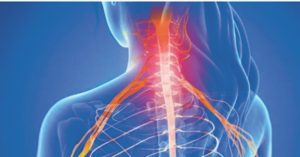By Dr. Danielle Zappile


Radiculopathy: Unraveling the Nerve Root Culprit
Picture your spine as a superhighway of nerves connecting your brain to the rest of your body. Radiculopathy is like a traffic jam on this highway, occurring when a spinal nerve root becomes compressed, irritated, or inflamed. This nerve blockade can lead to pain, numbness, weakness, or altered sensations along the nerve’s pathway. Common causes for radiculopathy include herniated discs, spinal stenosis, and foraminal stenosis. Depending on the affected region, radiculopathy can strike the neck (cervical), mid-back (thoracic), or lower back (lumbar).
Neuropathy: A Journey into the Realm of Peripheral Nerves
While radiculopathy focuses on spinal nerve roots, neuropathy can encompass various conditions that affect the peripheral nerves – the nerves branching out from the brain and spinal cord. The causes of neuropathy are vast, ranging from diabetes, alcohol abuse, and vitamin deficiencies to autoimmune diseases and chemotherapy. Neuropathy can effect a single nerve (mononeuropathy) or cast a wider net, affecting multiple nerves (polyneuropathy).
The Common Ground: Symptoms and Diagnostic Tools
Now that we’ve explored the distinct territories of radiculopathy and neuropathy, let’s take a look at the common ground they share:
1. Symptoms: Both conditions can cause pain, numbness, tingling, weakness, and altered sensations in the affected areas. This overlapping array of symptoms can blur the lines between the two conditions, making them difficult to differentiate.
2. Diagnostic Tools: To help untangle this web of symptoms, nerve conduction studies and electromyography (EMG) serve as valuable allies for diagnosing both radiculopathy and neuropathy. These tests delve into nerve function, helping to pinpoint the location and severity of the problem. Simpler test can be performed in a doctor’s office for faster identification of underlying causes.
The Great Divide: Anatomical Location, Causes, and Symptom Distribution
As we venture further into the realms of radiculopathy and neuropathy, we encounter key differences that set them apart:
1. Anatomical Location: While radiculopathy lies within the spinal nerve roots, neuropathy roams the peripheral nerves. This distinction becomes crucial when considering imaging studies like MRIs for radiculopathy and nerve testing and grading for neuropathy.
2. Causes: Radiculopathy typically arises from mechanical issues affecting the spinal nerve roots, whereas neuropathy boasts a broader array of causes, including metabolic, toxic, and hereditary factors.
3. Symptom Distribution: Radiculopathy generally follows a specific pattern, aligning with the affected spinal nerve root. In contrast, neuropathy often adopts a more diffuse or “stocking-glove” distribution, particularly in polyneuropathy cases.
Treatment Strategies: A Personalized Approach
Treating radiculopathy and neuropathy requires a tailored approach, taking into account the underlying cause, severity, and duration of symptoms.
For radiculopathy, conservative treatments include pain management, VAX-D spinal decompression, and activity modification. In more severe cases, epidural steroid injections or surgery may be necessary.
Neuropathy treatment focuses on symptom management with medications targeting pain, such as anticonvulsants or antidepressants. Addressing the underlying cause, like better blood sugar control for diabetic neuropathy, is essential. HakoMed Horizontal therapy or Sanexas RST and lifestyle modifications can also help improve function and reduce symptoms.
Conclusion: Embracing the Body’s Natural Healing Powers
Radiculopathy and neuropathy, while distinct conditions with overlapping symptoms, require a deep understanding of their differences in causes, anatomical involvement, and symptom distribution to ensure accurate diagnosis and appropriate treatment. Healthcare providers rely on a combination of history-taking, physical examination, and diagnostic tests to differentiate between these conditions.
As more individuals embrace the body’s natural ability to heal, many are turning to complementary therapies alongside conventional treatments. By tailoring treatment strategies to the specific cause and severity of radiculopathy or neuropathy and incorporating natural healing approaches, patients can achieve better outcomes and an improved quality of life. Empower yourself with knowledge about these conditions and take an active role in your journey towards optimal health and wellness.
(239) 202-0999
StraightToHealth.com
Dr. Danielle Zappile has been a chiropractic physician since 2009 and has helped thousands of patients achieve their health goals.
Expect Better.
Demand Better.
Get Better.
 Southwest Florida's Health and Wellness Magazine Health and Wellness Articles
Southwest Florida's Health and Wellness Magazine Health and Wellness Articles

